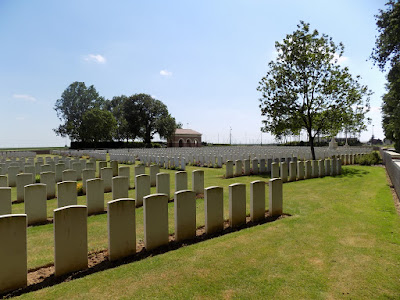Albert Milton
1897-April 11th 1917
Albert Edward Milton was born in Hascombe in Surrey, the
third of seven children of William Milton and Caroline Underwood. William and
Caroline were married in 1890 and their first child, William, was born in 1891.
He was followed by Caroline in 1893, Alice in 1894 and Andrew in 1895. Albert
arrived two years after that then Vernon in 1901 and finally John in 1902.
Albert’s father William worked as a coachman but with so many big houses in the
area, it is not clear who his employers were.
Albert joined up at Guildford on 30 Oct 1915. He was then living at The Cottage, Hascombe
and was a footman and he was assigned to The Royal Garrison Artillery 142nd
Siege Battery as a gunner. The soldiers in siege batteries operated heavy guns
and howitzers which were attached to solid platforms or mounted on railway
trucks. The 142nd battery went to France in August 1916, having been
formed in May of that year. Their guns included 6.6 inch howitzers each manned
by a crew of ten.
The winter of 1916/17 had been very quiet with little
progress on either side. However in the spring of 1917, allied troops gained
huge ground and took back many villages along the Western Front. This was also
a time of much increased air activity with bombing and reconnaissance aircraft
in use on both sides. In spite of the successful pushing back of the German
lines by the allies, the Germans were still dug in over an eight hundred
kilometre lines from the North Sea to the Swiss border. Planning began for a
new offensive in the Arras Sector of the Western Front. Huge numbers of troops
were deployed all along the front line and the action lasted from April 9th
to May 16th. Commanders had made use of underground caverns beneath
the city of Arras to shelter the men. These caves were so extensive they housed
a hospital, a telephone exchange and even had a tramway to connect them.
142nd Siege Battery had moved around France during
their time there and by the spring were located near Arras as part of this
offensive. In April they were attached to the Canadian Corps who were tasked
with retaking Vimy Ridge, a prominent landmark in the area. The siege battery’s
role was to bombard the enemy with heavy gun and shells and on the first day of
the battle, April 9th, the battery was in constant demand to clear
the area and provide cover. However, the Germans were responding and in the
middle of the day, 142nd Siege Battery were hit by a salvo of
shells. Some of the men died instantly, others over the next few days. Albert
Milton was listed as having died from his wounds on 11 Apr 1917, two days later.
A letter dated 9th June was sent to his father at Stillwell
Cottage Hascombe. In October another letter was sent to The Lodge Sladeland
Billingshurst Sussex. Sladeland is in Kirdford so the family had obviously
moved on.
In 1919, his father William listed all the family in reply
to a letter from the army records office and the witness to the document was
E.A. Bennet, vicar of Kirdford. The family listed as William and Caroline
Milton, parents, and two brothers, William John aged 27 at Mesopotamia, and
John aged 16 on HMS Impregnable in Devon. His two sisters Caroline aged 26 at
The Lodge Sladelands and Alice aged 25 in London. Albert’s brother Andrew had
died aged 6 and Vernon had been killed in 1918.
The family lived on in Godalming. Frederick’s mother,
Caroline passed away in 1938. In 1939, William was living with his unmarried
daughter Alice, son William and William’s wife Rhoda. He died in 1941.
In Memory of
Gunner Albert Edward
Milton
Royal Garrison
Artillery 142nd Siege Bty
who died on 11 April
1917 Age 19
Remembered with
Honour
Bethune Town Cemetery



